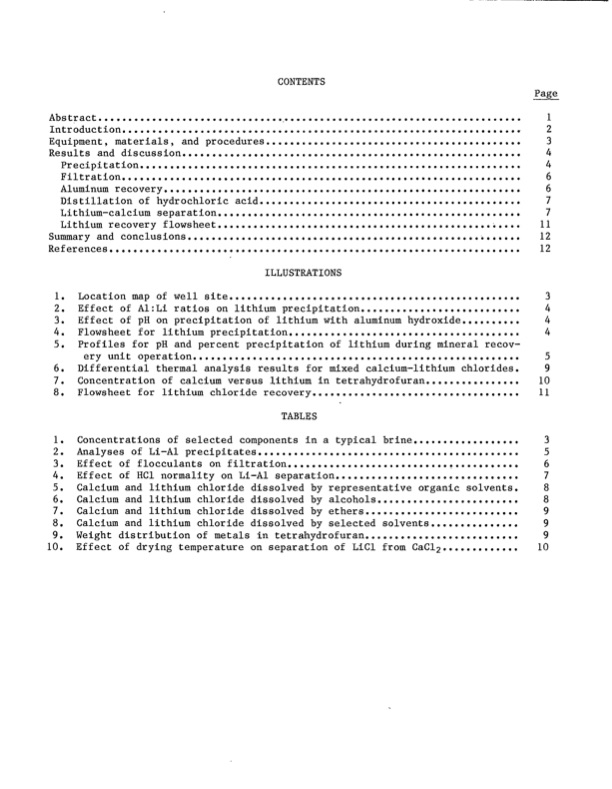
PDF Publication Title:
Text from PDF Page: 004
CONTENTS Abst':f8Ct •••••••••••••••••••••••••••••••~.... ••• •••••••••• ••••••••••• ••••••••• ••• 1 Introduction•••••••••••••••••••••••••••••••••••••••••••••••••••••••••••••••••• e' 2 Equipment, materials, and procedures........................................... 3 Results and discussion ••••••••••••••••••••••••••••••••••••••••••••••••••• Q..... 4 Precipitation.. ••• ••••••••••••••• •••••••• • •• •• ••••••••••• •••• •••••••••••••••• 4 Filtration................ ••••.•••• •• .••• •••••• •.• •••• •• ••••••••.•••••••••••• 6 Aluminum recovery............................................................ 6 Distillation of hydrochloric acid............................................ 7 Lithium-calcium separation................................................... 7 Lithium recovery flow sheet................................................... 11 Summary and conclusions........................................................ 12 References. ••••••• ••• •••••••••••••••••••••••••••••••••••••••••••••• •••••••• •••• 12 1. 2. 3. 4. 5. 6. 7. 8. ILLUSTRATIONS Location map of well site ••••••••••••••••••••••••••••••••••••••••••••••••• 3 Effect of Al:Li ratios on lithium precipitation••••••••••••••••••••••••••• 4 Effect of pH on precipitation of lithium with aluminum hydroxide•••••••••• 4 Flowsheet for lithium precipitation••••••••••••••••••••••••••••••••••••••• 4 Profiles for pH and percent precipitation of Hthium during mineral recov- ery unit operation••••••••••••••••••••••••••••••••••••••••••••••••••••••• 5 Differential thermal analysis results for mixed calcium-lithium chlorides. 9 Concentration of calcium versus lithium in tetrahydrofuran•••••••••••••••• 10 Flowsheet for lithium chloride recovery••••••••••••••••••••••••••••••••••• 11 TABLES Concentrations of selected components in a typical brine•••••••••••••••••• 3 Analyses of Li-AI precipitates •••••••••••••••••••••••••••••••••••••••••••• 5 Effect of flocculants on filtration ••••••••••••••••••••••••••• , ••••••••••• 6 Effect of HCl normality on Li-Al separation••••••••••••••••••••••••••••••• 7 Calcium and lithium chloride dissolved by representative organic solvents. 8 Calcium and lithium chloride dissolved by alcohols•••••••••••••••••••••••• 8 Calcium and lithium chloride dissolved by ethers•••••••••••••••••••••••••• 9 Calcium and lithium chloride dissolved by selected solvents••••••••••••••• 9 1. 2. 3. 4. 5. 6. 7. 8. 9. Weight distribution of metals in tetrahydrofuran•••••••••••••••••••••••••• 9 10. Effect of drying temperature on separation of LiCl from CaClz••••••••••••• 10PDF Image | Recovering Lithium Chloride From a Geothermal Brine 1984

PDF Search Title:
Recovering Lithium Chloride From a Geothermal Brine 1984Original File Name Searched:
cdc_10654_DS1.pdfDIY PDF Search: Google It | Yahoo | Bing
Product and Development Focus for Infinity Turbine
ORC Waste Heat Turbine and ORC System Build Plans: All turbine plans are $10,000 each. This allows you to build a system and then consider licensing for production after you have completed and tested a unit.Redox Flow Battery Technology: With the advent of the new USA tax credits for producing and selling batteries ($35/kW) we are focussing on a simple flow battery using shipping containers as the modular electrolyte storage units with tax credits up to $140,000 per system. Our main focus is on the salt battery. This battery can be used for both thermal and electrical storage applications. We call it the Cogeneration Battery or Cogen Battery. One project is converting salt (brine) based water conditioners to simultaneously produce power. In addition, there are many opportunities to extract Lithium from brine (salt lakes, groundwater, and producer water).Salt water or brine are huge sources for lithium. Most of the worlds lithium is acquired from a brine source. It's even in seawater in a low concentration. Brine is also a byproduct of huge powerplants, which can now use that as an electrolyte and a huge flow battery (which allows storage at the source).We welcome any business and equipment inquiries, as well as licensing our turbines for manufacturing.| CONTACT TEL: 608-238-6001 Email: greg@infinityturbine.com | RSS | AMP |